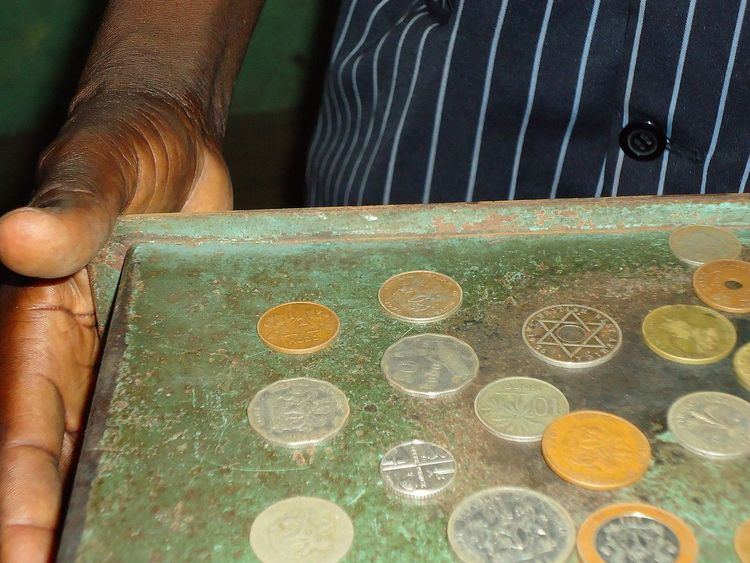Code NGN Plural Naira Symbol ₦ | 1/100 Kobo Kobo Kobo | |
 | ||
Banknotes 5, 10, 20, 50, 100, 200, 500 & 1000 Naira | ||
The naira (sign: ₦; code: NGN) is the currency of Nigeria. It is subdivided into 100 Kobo.
Contents
The Central Bank of Nigeria (CBN) is the sole issuer of legal tender money throughout the Nigerian Federation. It controls the volume of money supply in the economy in order to ensure monetary and price stability. The Currency & Branch Operations Department of the CBN is in charge of currency management, through the procurement, distribution/supply, processing, reissue and disposal/disintegration of bank notes and coins.
History
The naira was introduced on 1 January 1973, replacing the pound at a rate of 2 naira = 1 pound. This made Nigeria the last country to abandon the £sd currency system. There was a plan to redenominate the naira at 1 new naira = 100 old naira in 2008, but the plan has been suspended. The currency sign is U+20A6 ₦ Naira sign.
Rampant inflation has occurred in Nigeria over the existence of naira. The Central Bank of Nigeria claimed that they attempted to control the annual inflation rate below 10%. In 2011, the CBN increased key interest rate for 6 times, rising from 6.25% to 12%. On 31 January 2012, the CBN decided to maintain the key interest rate at 12%, in order to reduce the impact of inflation due to reduction in fuel subsidies.
As of 20 June 2016, the naira was allowed to float, after being pegged at 197 to the US dollar for several months. Trades speculated the natural range of the naira would be between 280 and 350 to the dollar.
Coins
In 1973, coins were introduced in denominations of ½, 1, 5, 10 and 25 kobo, with the ½ and 1 kobo in bronze and the higher denomnations in cupro-nickel. The ½ kobo coins were only minted that year. In 1991, smaller 1, 10 and 25 kobo coins were issued in copper-plated-steel, along with nickel-plated-steel 50 kobo and 1 naira. On 28 February 2007, new coins were issued in denominations of 50 kobo, 1 and 2 naira, with the 1 and 2 naira bimetallic. Some Nigerians expressed concerns over the usability of the ₦2 coin. The deadline for exchanging the old currency was set at 31 May 2007. The central bank stated that the ½ to 25 kobo coins were withdrawn from circulation with effect from 28 February 2007.
Banknotes
On January 1, 1973, the Central Bank of Nigeria introduced notes for 50 kobo, 1, 5, 10 and 20 naira. The 50 kobo notes were last issued in 1989. In 1991, 50 naira notes were issued, followed by 100 naira in 1999, 200 naira in 2000, 500 naira in 2001 and 1000 naira on October 12, 2005.
On February 28, 2007, new versions of the 5 to 50 naira banknotes were introduced. Originally the 10, 20 and 50 naira were to be polymer banknotes, but the 5,10 and 50 were delayed to late 2009 and only the 20 was released in polymer. The notes are slightly smaller (130 x 23 mm) and redesigned from the preceding issues. In mid-2009 when Sanusi Lamido Sanusi took over as CBN Governor he eventually changed the 5, 10 and 50 naira to polymer notes.
On the 1000 naira notes, there is a subtle shiny strip running down the back of the note. It is a shimmery gold colour showing 1000 naira. The triangular shape in the middle of the front of the note changes its colour from green to blue when tilted. The main feature on the front is the engraved portraits of Alhaji Aliyu Mai-Bornu and Dr Clement Isong, former governors of the Central Bank of Nigeria.
On the first prints of the 100 naira notes issued starting December 1, 1999, Zuma Rock was captioned as located in Federal Capital Territory, while actually it is situated in Niger State. Later prints removed the reference to FCT, ABUJA.
In 2012 the Central Bank of Nigeria may be contemplating the introduction of new currency denominations of N5,000. The bank has also made plans to convert ₦5, ₦10, ₦20 and ₦50 into coins which are all presently notes.
The Central Bank of Nigeria has announced that it will no longer issue banknotes on polymer citing higher costs and environmental issues.
On November 12, 2014, the Central Bank of Nigeria issued a 100 naira commemorative note to celebrate the centennial of Nigeria's existence. The notes are similar to its regular issue with the portrait of Chief Obafemi Awolowo on front, but is redesigned to include a new color scheme, revised security features, the text "One Nigeria, Great Promise" in microprinting and on the back is a quickresponse code (QRC) which when scanned leads users to a website about Nigeria's history.
Second naira
The naira was scheduled for redenomination in August 2008, although this was cancelled by then-President Umaru Musa Yar'Adua), with 100 old naira to become 1 new naira. The Nigerian Central Bank stated that it will make the naira fully convertible against foreign currencies by 2009. Currently, the amount of foreign currency is regulated through weekly auctions, while the Central Bank sets the exchange rate. The naira appreciated against the dollar through 2007 due to high oil revenues. Also, the then-Bank Governor, Professor Chukwuma Soludo noted the weekly central bank auctions of foreign currency will gradually be phased out, and that the bank would "only intervene in the market as may be required to achieve defined policy objectives".
Coins
Coins were to be issued in denominations of:
Banknotes
Banknotes were to be printed in denominations of:
Exchange rates
This table shows the historical value of one U.S. Dollar in Nigerian naira - PM = Parallel Market.
